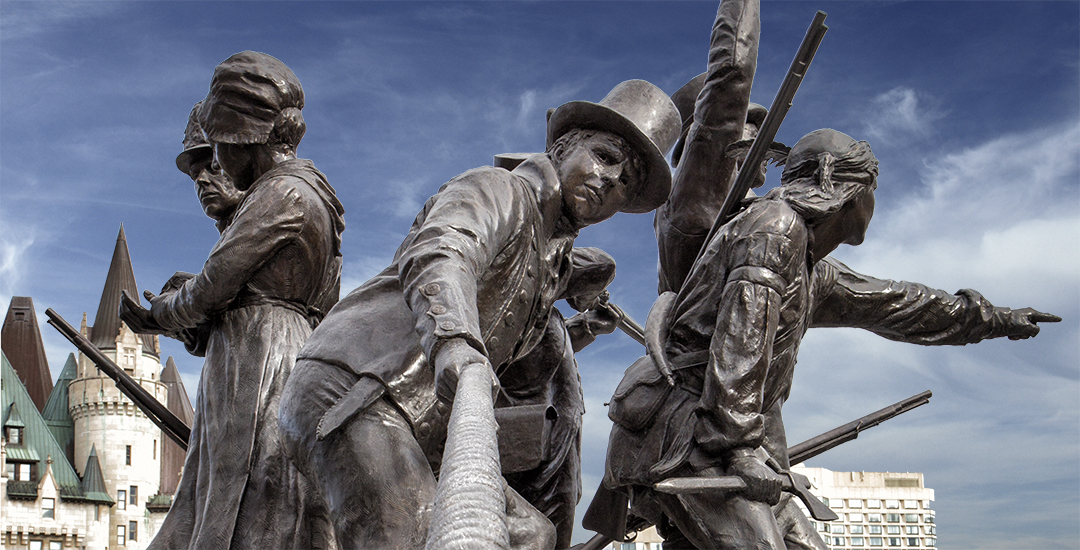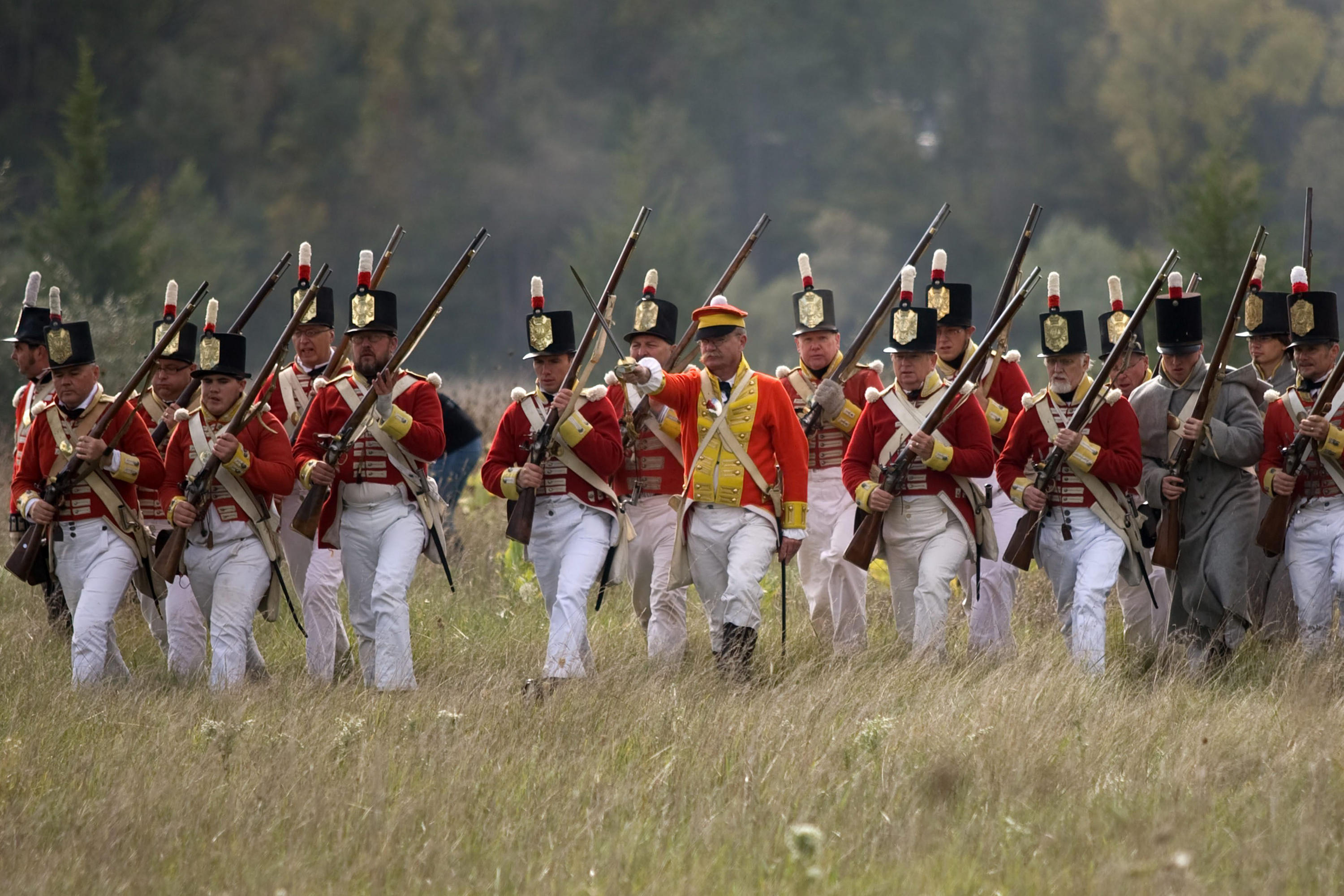A monument to Canada’s formative experience during the War of 1812

Triumph Through Diversity is a monument commemorating the 200th anniversary of the War of 1812’s final battle in Canada, the Battle of Malcolm’s Mills. It is located on Parliament Hill, Ottawa—just across from the National War Monument. Triumph Though Diversity is unique as a war monument in that it commemorates not just the mere fact of the conflict and those who fell in its pursuit, but commemorates the disparate peoples who came together and rallied behind a common purpose; to defend Canada from an American invasion during that time. This is especially important to consider, as it highlights the formative nature of the War of 1812—not just as a territorial conflict, but as an origin story for a then young nation.
The bronze monument was dedicated on November 6th, 2014, at a cost of approximately $2 million USD, and was sculpted by Toronto artist Adrienne Alison. At 3 meters tall and four meters long, the sculpture features seven figures from different Canadian peoples of the era: a Mohawk warrior, a Royal Navy sailor, a member of the French-Canadian militia’s Voltigeurs regiment, a Metis militiaman, a British regular, and a female nurse. The figures are seated on a plinth, with boats on either side—symbolizing the various theaters, land and sea, where the war was fought. Also part of the monument is a maple tree, planted in soil taken from ten Canadian battlefield sites and watered at the dedication with water from six oceans and lakes significant in the War of 1812. The tree is meant to symbolize the Canadian nation that grew out of the unifying effort to defend Canada against the American invasion during the War of 1812, as well as pay tribute to the many naval battles that played a part throughout the war.
Many Backgrounds, One Purpose

With respect to each group depicted in the monument, their role in the Canadian war effort against the United States of America in 1812 cannot be understated. While this page cannot serve as an exhaustive dive into each group’s contributions, a general overview and understanding can be helpful for appreciating the Triumph Through Diversity monument.
The Mohawk warrior featured in the monument represents the many native peoples and their contribution to the defense of Canada and her population. For example, many Ottawa and Ojibiwa forces, led by British regulars, assisted in the capture of Fort Mackinac (then Fort Michilimackinac). Perhaps most famous of the native warriors is Tecumseh, who led his primarily Shawnee forces to many a victory in the Detroit area. In truth, Tecumseh and his Ohio Valley warriors proved a powerful ally simply by reputation alone; in his letter to General William Hull demanding surrender, Major-General Isaac Brock explicitly uses Tecumseh and his native warriors as a toll of intimidation, commenting on his inability to control the warriors one the fighting breaks out. It should be noted that General Hull promptly accepts, and surrenders Detroit to Tecumseh and Brock. The actual Mohawk warriors themselves, representing a tribe of the Iroquois, were led into battle by Joseph Brant (Thayendanegea) and John Norton. These warriors, hailing from the Six Nations of the Grand River, would be critical combatants in many high-profile conflicts throughout the war, such as the battles of Queenston Heights, Stoney Creek, and Chippawa, where they would fight alongside British regulars, common militiamen, and other first Nations peoples.
England’s Royal Navy, too, more than pulled their weight throughout the conflict. Given that the United Kingdom was occupied with a war against France at the time, British policy was to commit minimal forces the American war front; this meant that larger ships, such as the infamous men-of-war, were largely kept across the ocean. This meant the Royal Navy in Canada was forced to rely on small vessels engaging in largely single-ship conflict and merchant shipping disruption. Despite these limitations, the Royal Navy was able to execute a remarkably successful blockade around many American ports, such as Charleston, Port Royal, and even New York City. So effective was the navy’s blockade, American exports decreased from $130 million to just $7 million in two years. The Royal Navy’s story during the War of 1812 is one of achieving exceptional results with minimal resources.
Also featured in the monument are the Voltigeurs. These French-Canadian soldiers were raised from high society prior to the outbreak of the war, in preparation for conflict. As full-time regulars distinct from the normal British army, these soldiers were distinctly Canadian, and can in many ways be thought of as the beginning of Canadian military identity. Led by the seasoned and well-regarded Major Charles-Michel de Salaberry, the Voltigeurs served honorably as a highly effective force of incredibly disciplined and lethal servicemen. Notable battles featuring the Voltigeurs include the Battle of Lacolle Mills, where American General Henry Dearborn was repulsed; the Second Battle of Sackett’s Harbor; and the Battle of Crysler’s farm, where the elite regiment successfully defended against a force superior in numbers. While the Voltiegurs were short-lived—having been dismantled in 1815—they remain an ancestral root for many Canadian fighting forces that would be raised in wars to come.
The Metis militia man featured in the monument pays homage not just to the Metis people (who trace their heritage to the joining of First Nations natives and early French settlers) but to the many indigenous peoples of Canada that trace their descent to First Nations peoples. By 1812, the Metis were well-established in the Great Lakes region, particularly in the fur trade. Recognizing the potential disruption to their culture and economy by an American takeover, the Metis sided with the British during the war. They provided a spirited defense of Canadian lands throughout the war, participating in major battles near the front line, such as Joseph Island, Sault Ste. Marie, and Mackinaw St. While they primarily fought alongside other first Nations peoples, or as part of normal militia units, there were some almost entirely Metis units—such as the Corp of Canadian Voyageurs, the Mississippi volunteers, and the Michigan Fencibles. The contribution of the Metis people in the War of 1812 is perhaps the most forgotten today, despite being foundational to the Canadian identity we see today, spawned from their integration with diverse units during the war.
Providing the professional foundation for the Canadian defense throughout the war was the British regular. These highly disciplined, experienced soldiers often served as officers, training and leading militia units into battle. Though outnumbered by the Americans, in terms of professional soldiers, British regulars proved excellent at forging effective combat units out of otherwise unprofessional fighters (see the Voltigeurs). The “Fencibles”, temporary units raised from local populations, were particularly effective—providing men to garrison and defend Canadian lands while the fighting forces comprised of the British regulars could focus on offensive maneuvers. The presence of these distinctly British soldiers fighting alongside the more “Canadian” colonists helped shape the unique relationship Canada still maintains with its parent country today.
The final group depicted in Triumph Through Diversity—and almost excluded from the monument, saved only by petition from the sculptor to the Canadian government—is the Canadian woman. Canadian women, though absent from much of the fighting itself, nonetheless occupied many vital roles throughout the conflict. Largely, these roles included munitions manufacturing and nursing. Beyond helping with the war effort, however, the inclusion of woman in the monument serves as a reminder for the sacrifices made by many women throughout the war by virtue of their identity; women often suffered the most when armies rolled through their villages, and were forced to bear the brunt of labor typically performed by men during peacetime. Perhaps most famous of the many women who served during the War of 1812 is Laura Second, who in 1813 warned British forces of an impending American attack after walking over 20 miles (32 km) out of American-occupied territory. Her story has grown to legendary proportions today, with several movies, plays, and books detailing her life and heroism—further highlighting her, and women in generals, role in the war and integration into Canadian identity today.
In Remembrance

Remembering the War of 1812 as an origin story is a sentiment that has seen some criticism in recent years, and it would be irresponsible to speak on the subject—especially the monument—without touching on that controversy. Many historians have been quick to point out that only a relatively small portion of the then British province saw conflict. What’s more, the bicentennial day of remembrance for the War of 1812 has seen some backlash from many Canadians, especially in French-Canada, who see the installment of the monument and celebration of the war as glorification of a martial history that many view as distinctively un-Canadian. Some scholars also point out the political underpinnings of the recent administration’s newfound focus on the war, particularly the installment of the monument; a focus on Canada’s martial history may serve the interests of more Right-leaning political factions within the Canadian political landscape. Nonetheless, despite these doubts, the War of 1812 without a doubt remains important to Canada’s origin, if not as earth-shatteringly integral as some perspectives may claim it to be.
It certainly helped form a sense of national identity in the minds of today’s populace, as seen in 2012 IPSOS polls, where Canadians cited the War of 1812 as the second most defining aspect of their nation, behind their healthcare system. Many respondents also saw the War of 1812 as functionally critical to the formation of the Canadian nation, as well. This creates in interesting philosophical question surrounding the War of 1812, and punctuated by Triumph Through Diversity; even if the war was not historically foundational to the Canadian identity as we know it today, if it is believed to be foundational in the eyes of today’s Canadians, does that not make the war a foundational touchtone anyways, in and of itself? This is a question the demands exploration by scholars of Canadian history, and will likely determine how the monument on Parliament hill will be viewed in the eyes of historians.
Regardless of recent protestation against emphasizing the War of 1812’s role in Canadian history, and the questions raised by such controversy, it seems clear that the conflict was integral—if not actually, then at least in the minds of many Canadians—to the inception of Canada as we know it today. The monument beautifully represents the coming together of diverse peoples across great swathes of land and sea, coming together in defense of a common purpose, a common place, and a common idea that would come to be known as Canada. Alison’s Triumph Through Diversity does in exemplary job of capturing that unifying sentiment, regardless of its historical truth.
Primary Sources:
- Gray, William. “The Montreal Herald.” Google News Archive Search, Google, 4 July 1812
- Brock, Isaac, and Ferdinand Brock. Tupper. The Life and Correspondence of Major-General Sir Isaac Brock. 1981
- George Prevost. “Letter to Earl Bathurst” 26 August 1812
- Isaac Brock. “Letter to Hend Quarters, Sandwich” 15 August 1812
- William Rawson. “The Migration of Voyageurs from Drummond Island to Penetanguishene in 1828” 1828
Secondary Sources:
- Whyte, Murray. “Toronto Sculptor Adrienne Alison Creates Monument to War of 1812.” Thestar.com, 27 June 2013
- “War of 1812.” The Canadian Encyclopedia, 6 Mar. 2012
- Tiro, K. “Now You See It, Now You Don’t: The War Of 1812 In Canada And The United States In 2012” The Public Historian,35(1), 87-97, 2013
- Stacey, C. P. “The War of 1812 in Canadian History” Ontario History, L(3), 153–159, 1958
- Sjolander, Claire Turenne. “Through the Looking Glass: Canadian Identity and the War of 1812.” International Journal: Canadas Journal of Global Policy Analysis, vol. 69, no. 2, 2014
- Utt, Ronald D. Ships of Oak, Guns of Iron: the War of 1812 and the Forging of the American Navy. Regnery History, 2016.
- Pennington, Reina. Amazons to Fighter Pilots: a Biographical Dictionary of Military Women. Greenwood Press, 2003
Further Reading

